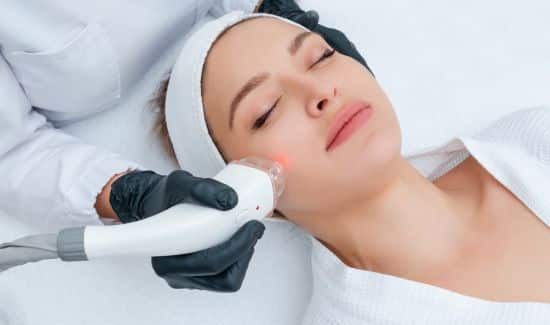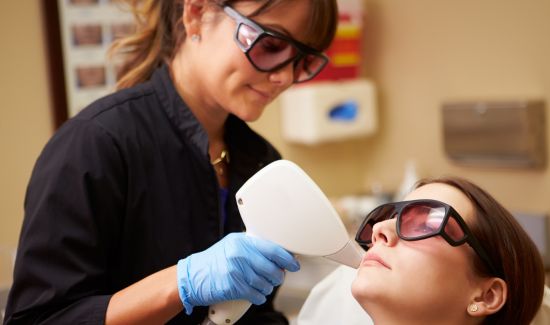Facial Laser Treatments Side Effects

Are you worried about your acne, aging, wrinkles, or lines and looking for a solution in the form of skin laser resurfacing? Then you must know the risks associated with laser facial treatment because facial laser is not a method without side effects. Most of the time, it is accompanied by complete failures, according to studies. In this article, you will learn the side Effects of Laser Treatment for Skin and overall health and how to minimize them.
What Is Resurfacing Laser:
Laser resurfacing improves the skin’s appearance and removes minor flaws. Two types of facial laser treatment can be further divided.
1- Ablative Laser.
2- Non-ablative Laser or Light Resource.
Why it is done:
Laser for skin resurfacing can be used to treat:
– Age spot.
– Uneven skin texture.
– Sun-damaged skin.
– Fine Lines
-Wrinkles
– Moderate Acne scars.
The specific laser types used will depend on factors such as your skin type, areas of concern, and desired results. Each treatment type may have some pros and cons, so it’s essential to consider your goals and expectations before selecting a face treatment laser.
Side Effects Of Laser Treatment For Skin:
Laser resurfacing comes with some side effects and risks. Non-ablative approaches tend to have milder and less frequent side effects than ablative laser resurfacing. Some common disadvantages of facial lasers are:

1- Redness and irritation.
2- Alteration in skin color.
3- Skin infections
4- Skin crusting and crumbling
5- Excessively dry skin.
6- Risk of pigmentation.
7- It shows slow results.
8- Risk of eye injury.
9- High-cost method.
10- Acne.
11- Scaring.
12- Contact Dermatitis.
1. Redness And Irritation- Minor Laser Therapy Side Effects:
Skin laser treatment can have some side effects, including irritation and redness. Irritation is a common disadvantage of the treatment and is noticeable in almost every individual undergoing it. In some rare cases, the skin may even feel pain and appear to bulge. However, most people only experience temporary irritation that lasts a few hours.
How to overcome:
To overcome the irritation, use ice packs or cold water. It’s important to note that these side effects are typically mild and temporary.
2. Alteration In Skin Color:
Alteration in skin color is one of the common side effects of the skin rejuvenating process. Depending on the individual’s skin type, this change can be either darker or lighter than the original skin tone.
Those with lighter skin may experience a dimmer change, while those with darker skin may experience a lighter change. However, these alterations are usually temporary and fade over time, so worrying too much is unnecessary.
3. Skin Infections:
Skin treatment with laser can cause various skin infections. These may include:
- Redness.
- Swelling.
- Blistering.
Sometimes, bacterial infections also occur, which can be treated with antibiotics prescribed by a laser resurfacing dermatologist.
How to overcome:
It is essential to avoid using over-the-counter antibiotic dermis creams, as they may not be effective and could even make the infection worse. Contact your healthcare provider immediately if you experience unusual symptoms after laser face treatment.
4. Skin Crusting and Crumbling:
One common side effect of laser facial treatments is crusting, which may occur in some skin regions. Another potential issue is crumbling, which can lead to scabbing and scarring if not properly managed.
How to overcome:
To minimize these side effects, taking good care of the treated area after the procedure is crucial. Good care may involve using a high-quality moisturizer or post-laser cream or seeking advice from a dermatologist.
5. Excessively Dry Skin:
The other side effect of laser is dryness of the skin, which can lead to further skin problems if not adequately addressed.
7. Risk Of Pigmentation:
Laser treatment for skin may result in changes in pigmentation, such as darkening or lightening of the treated area.
How to overcome:
To minimize the risk of these side effects, it is recommended to use sunscreen with an SPF of 30 before and after laser resurfacing. This will help protect the skin from further damage and maintain a more even tone.
8. It Shows Slow Results:
Face laser treatments can effectively treat scars, but it’s important to note that they can also have some side effects. One of the most frustrating aspects of this treatment is the time it takes to see results. Patients may become impatient and feel the process could be more effective if they see immediate improvement.
However, it’s important to remember that skin laser treatments can take several months to see significant results for scar therapy. It’s normal to see minimal change initially, but the desired outcome can be achieved with patience and consistent treatment.
9. Risk of Eye Injury:
Facial treatment lasers have some side effects, including the risk of eye injury. Eye injury is especially true for facial laser treatment, where high-powered lasers are often used.
How to overcome:
The patient and the practitioner must wear protective eyewear during the procedure to prevent potential eye harm. This precaution allows the treatment to proceed safely and effectively without any eye risk.
10. High-Cost Method:
A skin treatment by laser treats various conditions, but it has some potential side effects. However, these side effects are typically manageable and not severe. The main side effect of laser treatment is the cost, which is high.
How to overcome:
However, there are options for finding affordable treatment, such as consulting with a dermatologist who offers competitive pricing.
Rare Side Effects Of Laser Treatment On Face:
Laser facial treatment is generally safe and effective, but some rare side effects can occur.
1- Burns And Blisters:
It can happen if the treatment is not done correctly due to laser heat, but this is rare and can be prevented with proper cooling and skin type assessment.
2- Scarring:
Scaring is also a rare side effect of ablative laser resurfacing but can occur if the laser device is not used correctly or aftercare instructions are not followed.
3- Major Infections:
Other primary infections are rare but can occur if the skin is not adequately cared for after treatment or if there are underlying infections.
4- Ectropion:
The turning of the eyelid is a rare side effect that can occur if lasers are used close to the lower eyelid.
5- Changes In Skin Texture:
Changes in skin texture have also been reported and can occur if the skin has been recently tanned.
Who Should Not Have Lasers For The Face:
Laser therapy or skin rejuvenation treatments are not for all. Dermatologists recommend other treatments to those who have:
– A weakened immune system.
– Autoimmune diseases.
– Keloid scars.
– Previous laser resurfacing.
– Tendency to develop cold sores or herpes outbreaks.
– Darker skin tones.
– Laser on the face while pregnant or breastfeeding.
Discuss your medical history and any concerns with your doctor before undergoing laser resurfacing.
What To Avoid After Laser Treatment?

Laser treatments are typically safe, although certain risks are involved, as with any medical procedure. These are some ways to limit the complications and consequences of laser treatment:
– Select a certified and experienced doctor or technician with a proven track record of providing the required laser therapy.
– Guidelines for laser facial treatment before and after should be strictly followed, such as limiting sun exposure, tanning beds, and some drugs that might enhance light sensitivity.
– Use special goggles during the treatment to safeguard your eyes from laser injury.
– Following treatment, carefully follow post-treatment recommendations, such as:
- limiting sun exposure after facial laser treatment.
- using moisturizing cream after laser treatment.
- taking any recommended medications.
– Be mindful of possible side effects, including redness, swelling, and transient skin discoloration, and notify your doctor if you have any odd symptoms.
Laser treatments for skin rejuvenation may be very effective; however, working closely with a skilled practitioner is critical to avoid risks and get the best outcomes possible.
Frequently Asked Questions
1. How to repair laser-damaged skin?
Clean the treated areas four to five times each day after 24 hours. To prevent scab formation, apply an ointment such as petroleum jelly.
2. Is there a noticeable difference between different forms of laser therapy for the face before and after?
You do not notice an immediate change because the outcome takes time.
3. Do the laser resurfacing results are long-term?
One of the most obvious downsides of laser skin care treatment is that it does not generate long-term results.
4. What are the CO2 laser side effects?
The common side effects of CO2 laser resurfacing are:
– Itching.
– Swelling.
– Dryness.
5. What is a fractional CO2 laser?
Dermatologists and clinicians use fractional laser CO2 to minimize the appearance of acne scars, deep wrinkles, and other skin imperfections. It is a non-invasive therapy that employs a carbon laser facial to remove the outer layers of damaged skin.
Conclusion
Laser skin and hair removal treatments are generally safe and effective when performed by a qualified practitioner. However, like any medical procedure, there are potential side effects and risks of laser treatment. These side effects are typically easy to resolve and can be prevented with proper aftercare. Overall, laser treatment can be a safe and effective option for improving the appearance of your skin. Still, discussing concerns with your practitioner and following their aftercare instructions is essential.


I admire your enthusiasm for sharing information with your readers. Thanks for all that you do.
Thank you so much sherly.
Furthermore, i believe that mesothelioma is a uncommon form of many forms of cancer that is usually found in those people previously subjected to asbestos. Cancerous tissue form from the mesothelium, which is a protective lining that covers many of the body’s bodily organs. These cells typically form inside the lining of your lungs, abdomen, or the sac which actually encircles the heart. Thanks for giving your ideas.
Glad you like it
whoah this weblog is fantastic i like studying your posts. Keep up the good work! You realize, a lot of individuals are hunting around for this information, you could help them greatly.
Glad you like it. Please visit us for more informational blogs.
magnificent issues altogether, you just received a emblem new reader. What could you suggest in regards to your submit that you made some days in the past? Any certain?
Welcome Dear User:) Thank you for liking the blog please keep visiting.
Thank you
Somebody essentially help to make seriously posts I would state. This is the first time I frequented your website page and thus far? I amazed with the research you made to make this particular publish incredible. Great job!
For newest information you have to go to see internet
and on web I found this site as a most excellent site for newest updates.
king
Thanks on your marvelous posting! I quite enjoyed reading it, you happen to be a
great author.I will be sure to bookmark your blog and will
eventually come back someday. I want to encourage you to definitely continue
your great posts, have a nice weekend!